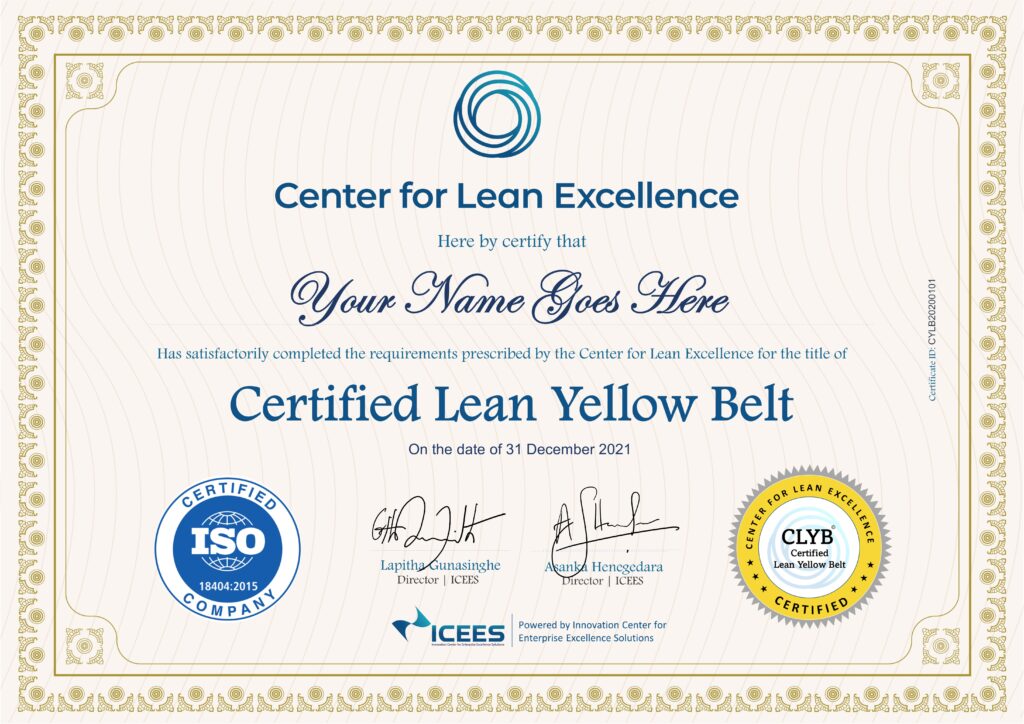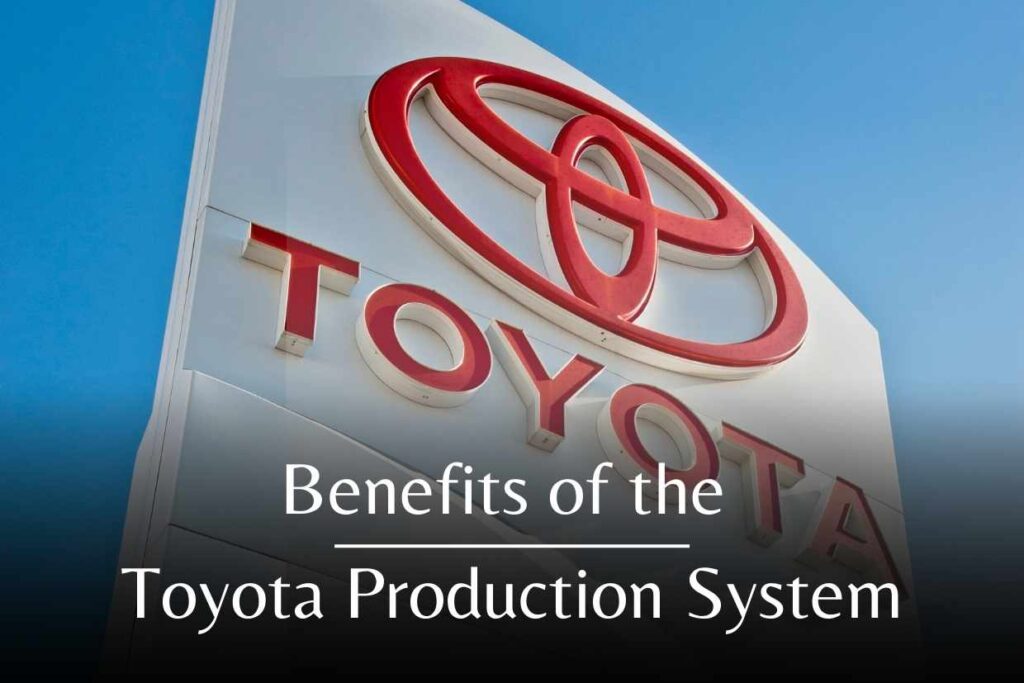With Lean Management Yellow Belt certifications, you will be able to outshine everyone and stand out among the rest, whether you are a seasoned expert or a brand-new beginning lean enthusiast aiming to enhance your professional career in any industry.
Before talking about the Lean Management Yellow belt, let us see what is meant by Lean Certifications.
What are Lean Certifications?

Lean Certifications are for you if you want to learn how to methodically manage complicated company operations while reducing waste, minimizing expenses, increasing production, and improving efficiency.
Lean Certification is a globally recognized and respected professional credential that validates your knowledge and ability to practically apply Lean management methodologies and helps you become a master of productivity.
Because of its broad application to operations inside firms of all sizes and its capacity to help them reach their business goals in a more thriving and sustainable way, lean management is gaining popularity in the business world.
Defining the worth of a good, service, or feature from the perspective of the customer, lean management is a long-term strategic approach intended to remove waste while continuously improving work processes.
The Yellow Belt certification is a vital part of lean management. This certification is an entry-level certification, and the goal of this entry-level certification is to instruct candidates in the fundamentals of lean management. For those who are curious about lean management and want to grasp the technique, it is a great place to start.
Lean certifications can help you in a variety of ways to advance your career in whichever industry you choose.
The followings are the four main Lean Certification Levels that are globally recognized in Lean management,
- Certified Lean Yellow belt
- Certified Lean Green belt
- Certified Lean Black belt
- Certified Lean Master black belt
What is Lean Management Yellow Belt?

The Certified Lean Yellow Belt is similar to a Certified Lean Initiator, and it is the first level of certification in lean management. It is a beginner-level course that provides an introduction to lean management principles and practices.
This Lean Initiator certification offers helpful advice on how to spot company waste that doesn’t improve the product and how to get rid of it.
Basically, the Yellow Belt certification is designed for individuals who are new to lean management and want to learn the basics of the methodology. Moreover, the Lean Management Yellow belt is ideally suited for leaders in the manufacturing industry as well as beginning lean enthusiasts.
What will you learn in the Lean Management yellow belt certification?

The Yellow Belt certification can be typically offered as a classroom or online course. The course covers the basics of lean management, including the history of lean management, the principles of lean management, and the tools used in lean management.
The course also covers the following topics:
1. Lean Management principles
There are 5 basic principles in Lean management, and they are identifying value, value stream mapping, creating a continuous workflow, establishing a pull system, and pursuing perfection. Lean management Yellow belt certification holders have a thorough knowledge of these principles.
- Identifying Value: Understanding what the customer values and identifying activities that add value.
By offering their consumers a product or service after determining the value from the customer’s perspective or stance, this idea tries to achieve what every business seeks to do. Simply said, the business must create value that meets the needs of its customers.
- Value Stream Mapping: Mapping the process flow from start to finish and identifying waste.
Value stream mapping is a Lean Management technique for describing and visualizing the stages used to produce a good or service from conception to delivery of value to the customer.
In addition, it also supports businesses in improving value flow while building a more effective, predictable, and agile system.
- Creating a continuous Workflow: Creating a smooth and continuous flow of activities to reduce lead time.
Once each team has mastered the value stream mapping, the workflow should continue to run smoothly. This principle aims to make sure that the stages that create value happens in the right order, allowing the product to reach the client as steadily and with high quality as feasible.
While creating a product or providing a service, breaking the task down into smaller batches and visualizing its process would make it simple to discover bottlenecks and interruptions and assist in preventing them.
- Establishing a Pull system: Establishing a system where the customer pulls the product or service based on demand.
Customer value is derived from the subsequent degree of activity once the flow has been started. A pull system must be established in order to have a consistent workflow that can complete jobs much more quickly and with less effort. Only when there is a demand is the job pulled in order to maximize resource capacity.
- Pursuing perfection: Developing standard procedures for all activities to eliminate variability and reduce waste.
To ensure that the other four principles are followed continuously and consistently, this principle is in place. Lean leaders engage in a sequence of continual improvements to strive for perfection in order to guide their organization toward a perfect value stream. There is no spectacular gesture or revolutionary change involved with lean management. It involves implementing tiny, gradual changes at every level of the business to increase productivity and efficiency while reducing waste.
2. 8 Types of Wastes and Practical Applications
There are 8 types of waste in lean management, also known as the “8 forms of waste” or “muda,”. They are,
- Overproduction – producing more than what is needed or producing it too early.
- Waiting – the idle time between processes or delays caused by poor scheduling.
- Transportation – unnecessary movement or relocation of goods or materials.
- Processing – unnecessary steps or processes that do not add value.
- Motion – unnecessary movement of people or equipment.
- Inventory – excess stock or unnecessary supplies that tie up resources.
- Defects – errors or defects in products or services that result in rework or waste.
- Non-utilized Talent – not utilizing the skills and expertise of employees to their fullest potential.
Lean management Yellow belt gives the knowledge about these 8 types of waste and teaches how to practically apply them by eliminating these wastes and how to improve efficiency, reduce costs, and increase customer value.
3. 5S for Productivity
The 5S concept is a system for organizing and maintaining a clean, safe, and efficient workplace. Further, it originated in Japan and stands for five Japanese words, each beginning with the letter “S.”
- Seiri (Sort) – Removing unnecessary items from the workplace
- Seiton (Set in Order) – Arranging necessary items in an organized and easily accessible manner
- Seiso (Shine) – Cleaning and maintaining the workplace
- Seiketsu (Standardize) – Establishing standardized processes and procedures for maintaining the workplace
- Shitsuke (Sustain) – Developing a culture of continuous improvement and adherence to the 5S principles
Lean management Yellow belt certification teaches how to improve workplace safety, efficiency, and productivity using this 5S concept.
4. Lean Process Mapping
Lean process mapping is a powerful technique used in Lean manufacturing to analyze and improve the flow of materials and information through a business process. It is a visual representation of a process that highlights areas of waste and inefficiency, with the goal of identifying opportunities for improvement and reducing costs.
Lean management Yellow belt provides insight into this Lean process mapping and how it leads to significantly improved productivity and good-quality products and services.
5. Gemba Kaizen for Continuous Improvement
Gemba Kaizen is a Japanese term that means “continuous improvement at the workplace.” It is a methodology that is based on the principle of continuous improvement through small, incremental changes that are made in the workplace. The term “Gemba” refers to the place where the actual work is done, and “kaizen” means continuous improvement. The Gemba Kaizen methodology is based on the idea that the people who do the work are the best source of ideas for improvement.
Lean management Yellow belt certification teaches its practitioners how to empower employees to identify and solve problems and to continuously improve their work processes. Plus, this also teaches how to help to foster a culture of continuous improvement, where everyone is committed to making the workplace more efficient, productive, and safe.
6. Systematic Problem Solving
Systematic problem-solving is a key aspect of Lean management, which is a philosophy that aims to reduce waste and improve efficiency in organizations. Lean management Yellow belt certification guides Lean beginners to identify the root causes of problems and implement solutions to prevent them from recurring in the future. Furthermore, they are given the knowledge to eliminate waste, improve quality, and increase efficiency through this approach.
7. A3 Thinking
A3 thinking is a problem-solving approach used in lean management. It is named after the size of the paper used to document the problem-solving process, which is typically an A3-sized sheet of paper (11 x 17 inches). The A3 thinking process is based on the Plan-Do-Check-Act (PDCA) cycle and is designed to help teams systematically identify and solve problems.
Lean management Yellow belt certification educates about this powerful tool for problem-solving and continuous improvement in lean management and further gives insight into how it helps teams to identify and address the root causes of problems and to develop and implement effective countermeasures. People with Lean Yellow belt certification follow a structured approach to the A3 thinking process and involve all team members in the problem-solving process, as it can lead to improved efficiency, quality, and customer satisfaction.
8. Lean Metrics
In Lean management, lean metrics are used to measure the performance of processes and identify areas for improvement and track progress over time. Organizations with Lean Management Yellow belt certified personnel use these metrics in Lean management to measure efficiency, quality, and customer satisfaction with their products or services.
9. Quality Circles
Quality circles are a powerful tool for improving processes and driving continuous improvement in Lean management. The quality circles help to create a culture of continuous improvement and drive efficiency, quality, and customer satisfaction by empowering employees to identify and solve problems within their work areas.
Lean Management Yellow belt provides knowledge on the steps of the quality circle process which are Problem Identification, Data Collection, Idea Generation, Solution Selection, Implementation, and Evaluation.
10. Visual Management (Visual Pyramid)
Visual management is another key component of Lean management, and it involves using visual cues and tools to help employees understand the status of processes and identify areas for improvement. The visual pyramid is a common visual management tool used in Lean management and it is a graphic representation of the key elements of a process, arranged in a pyramid shape with the most important elements at the top and the least important at the bottom.
By following a Lean management Yellow belt certification, one can learn how to help employees understand the critical elements of a process and focus their attention on the areas that are most important for improving efficiency, quality, and customer satisfaction through visual pyramids.
11. Team management
Team management is a critical component of Lean management that Lean Management Yellow belt holders are taught to practice in the right manner. As Lean initiatives are typically implemented through cross-functional teams that work together to improve processes and drive continuous improvement., effective team management is essential for ensuring that Lean initiatives are successful and sustainable over the long term.
12. Presentation skills
Along with all of the above-mentioned methodologies and techniques, the Lean management yellow belt also teaches the practitioners, presentation skills and other related skills needed to succeed.
Overall, the Yellow Belt certification provides individuals with an understanding of the basics of lean management. Plus, it teaches individuals the principles and tools of lean management and how they can be applied to improve business processes. Not only that, but the certification also prepares individuals for further training in lean management, such as Green Belt and Black Belt certifications.
Benefits of Lean Management Yellow Belt

There are several benefits to obtaining a Yellow Belt certification in lean management. Here are some of the key benefits
1. Improved efficiency
One of the main benefits of lean management is improved efficiency. The lean management Yellow Belt certification teaches individuals how to identify and eliminate waste in business processes. Therefore, this can lead to faster turnaround times, increased productivity, and reduced costs.
2. Better quality
As mentioned above, Lean management is focused on delivering value to customers. Along with improved efficiency, the Lean management Yellow Belt certification teaches individuals how to improve the quality of their products or services by eliminating defects and reducing variability in processes.
3. Increased customer satisfaction
Not to mention, Lean management is mainly customer-focused. This Lean management Yellow Belt certification guides individuals on how to identify customer needs and deliver value to customers. This will eventually lead to increased customer satisfaction and loyalty, helping the business to grow rapidly.
4. Improved teamwork
Lean management always emphasizes teamwork and collaboration. Giving individuals insight into how to work collaboratively with others to identify and eliminate waste in business processes is a vital part of lean management Yellow belt certification, and that is why businesses with Lean Yellow belt holders are reaching the peak of success more easily compared to other businesses in the same field.
5. Career advancement
Additionally, obtaining a Yellow Belt certification in lean management can lead to the career advancement of the certification holder. Undoubtedly, employers all over the world value individuals who have a deep understanding of lean management principles and practices.




